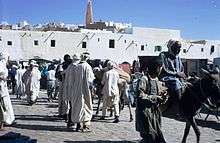Mozabite people
| Regions with significant populations | |
|---|---|
| Algeria | 150,000 Mozabite speakers (2007)[1] |
| Languages | |
| Mozabite (Tumẓabt), Arabic | |
| Religion | |
| Islam (Ibadi) | |
| Related ethnic groups | |
| Other Berbers[2] | |
The Mozabite people are a Berber ethnic group inhabiting the M'zab natural region in the northern Sahara in Algeria. They speak Mozabite (Tumẓabt), a branch of the Zenati group of Berber languages. Most also speak Arabic. Mozabites are Ibadi Muslims.
Mozabites live in five oases; namely, Ghardaïa, Beni Isguen, El Atteuf, Melika and Bounoura, as well as two other isolated oases farther north: Berriane and Guerrara.
History

According to tradition the Ibadis, after their overthrow at Tiaret by the Fatimids, they took refuge during the 10th century in the country to the southwest of Ouargla. They founded an independent state there.
In 1012, owing to further persecutions, they fled to their present location, where they long remained invulnerable.
After the capture of Laghouat by France, the Mozabites concluded a convention with them in 1853, whereby they accepted to pay an annual contribution of 1,800 francs in return for their independence. In November 1882, the M'zab country was definitely annexed to French Algeria.
Ghardaïa (population of 93,423) is the capital of the confederacy, followed in importance by Beni Isguen (4,916), the chief commercial centre.
Since the establishment of French control, Beni Isguen has become the depot for the sale of European goods. The Mozabite engineers built a system of irrigation works that made the oases much more fertile than they used to be.
Language
Mozabites speak Mozabite (Tumẓabt), a branch of the Zenati group of Berber languages.
Genetics
Mozabite people are characterized by a very high level of North African haplogroups E1b1b1b (M81) (86%) and U6 (28%).
Y-DNA
| Y-Dna | Nb | A/B | E(xE1b1b) | E1b1b1 (M35) | E1b1b1a (M78) | E1b1b1b (M81) | E1b1b1c (M123) | F | K | G | I | J1 | J2 | R1a | R1b | Other | Study |
| Y-chromosome DNA haplogroup | 67 | 0 | 4.5% | 0 | 1.5% | 86.6% | 1.5% | 0 | 0 | 1.5% | 0 | 1.5% | 0 | 0 | 3% | 0 | Dugoujon et al. (2009)[3] |
mtDNA
| mtDna | Nb | Eurasian lineages | sub-Saharan lineages (L) | North African lineages (U6, M1) | Study |
| Human mitochondrial DNA haplogroup | 85 | 54.1% | 12.9% | 33.0% | Coudray et al. (2009)[4] |
See also
References
- ↑ Tumzabt - Ethnologue (17th ed., 2013)
- ↑ http://www.tlfq.ulaval.ca/AXL/monde/famarabe.htm
- ↑ Dugoujon J.M., Coudray C., Torroni A., Cruciani F., Scozzari F., Moral P., Louali N., Kossmann M. The Berber and the Berbers: Genetic and linguistic diversities. In: Become Eloquent. Edited by J.M. Hombert and F. d’Errico. Ed. John Benjamins. pp 123-146; 2009
- ↑ "The complex and diversified mitochondrial gene pool of Berber populations". Ann. Hum. Genet. 73: 196–214. March 2009. doi:10.1111/j.1469-1809.2008.00493.x. PMID 19053990.
-
 This article incorporates text from a publication now in the public domain: Chisholm, Hugh, ed. (1911). Encyclopædia Britannica (11th ed.). Cambridge University Press.
This article incorporates text from a publication now in the public domain: Chisholm, Hugh, ed. (1911). Encyclopædia Britannica (11th ed.). Cambridge University Press. - A. Coyne, Le Mzab (Algiers, 1879); Rinn, Occupation du Mzab (Algiers, 1885)
- Amat, Le M'Zab el les M'Zabites (Paris, 1888)
| ||||||||||||||
| ||||||||||||||
